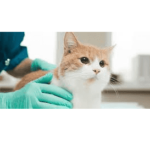Many owners feel that vaccinating their pet for something that he or she is not likely to come into contact with is not important. While in many cases this may be true, there are serious consequences when not vaccinating for a fatal disease like Rabies.

Rabies is the major virus almost every country regulates and monitors cats and dogs for. Un-vaccinated pets are often unable to travel due to regulations and should they every bite anyone, it is imperative you can show they have a current vaccination or a lengthy, expensive and stressful quarantine may be ordered.
Additionally, while we don’t see a whole lot of rabies cases in the US today, we do still see more instances then you may realize. One reason we see less cases than we used to is because most pet animals are vaccinated. This reduces the amount of virus in the population, which lowers everyone’s risk. Once owners stop vaccinating pets, the number of positive rabies cases in pets will rise. And with Rabies, there are no second chances. Once infected, the outcome is fatal and the risk of exposure to other animals and people is high.

Descriptions of rabies go back thousands of years as rabies has classically been one of the most feared infections of all time. It is caused by a virus that requires direct contact with infected mucous membranes to be transmitted. In most cases, disease is transmitted from the saliva of in infected animal by a bite wound or contact with a break in the skin. All mammals are susceptible to infection, wildlife being the primary animal group where infection occurs. When wildlife come into contact with humans or domestic animals, rabies becomes a public health problem. Despite vaccination being readily available, every year the U.S. reports approximately 50 canine deaths, 250 feline deaths, and several human deaths from rabies. Worldwide, some 55,000 human deaths occur annually from rabies, so it remains an important and nearly untreatable illness even now in the 21st century.

Rabies is almost always fatal once symptoms begin despite all the resources of modern medicine; it is important to take its threat seriously. It is because of rabies that most municipalities have dog licensing requirements to ensure that the community’s dogs (and in some areas, cats as well) are vaccinated.
The most common wildlife species to spread rabies to domestic animals and humans in the Northern Hemisphere are the skunk, bat, raccoon, fox, and coyote. Wildlife (especially bats) are able to gain access to indoor areas where they can come in close contact with both pets and people.
Many people do not realize how fast death occurs from rabies.
While it may take a long time for the virus to incubate, once even mild symptoms begin, death occurs within 10 days.
Course of the Disease

Even though death can be fast, it can also take up to a year from the time of the initial bite before symptoms begin to show. In dogs, typical incubation periods are 21-80 days. In cats, it’s 28-42 days. Once symptoms show, treatment is too late.
Virus from an infected animal’s saliva enters the victim’s tissues during a bite or break in skin. The virus attaches to muscle cells before penetrating to local nerves and beginning to move toward the brain. Once within nervous tissue, the virus is not accessible to the immune system and continues to move toward the brain. The journey is slow and can take up to a year but the average time is 3-8 weeks depending on the species and where the bite occured – the closer to the brain, the less time needed for the virus to travel and symptoms are seen sooner. Once the virus reaches the brain, it is only a matter of days before symptoms are seen and the virus is then shed in all body secretions, including saliva. The disease is now transmissible and death occurs shortly afterward.
Symptoms noted in companion animals
A change in personality is noted. Friendly animals become shy, etc. The larynx begins to spasm and a voice change may be noted (especially true in rabid cattle). Most infected animals will actively lick or scratch the site of the original bite.
Classically, this would be the “mad dog” stage, though in reality most dogs skip this phase altogether. The animal has no fear and suffers from hallucinations. If confined, the animal often attacks the bars of the cage.
Paralytic or Dumb Stage (Next 2-4 Days)
Weakness/paralysis sets in. The larynx and swallowing is paralyzed, resulting in drooling and “foaming at the mouth” result. The animal dies when the rib or intercostal muscles that control breathing are paralyzed. It is from animals in this stage where most human exposure occurs. There is no treatment for animals or humans once clinical signs appear.Skunk

Once the virus has been released to body secretions, it is again accessible to the immune system; however, the patient dies before an adequate immune response is mounted.
The classical symptoms of rabies described above may not be obviously recognizable, making diagnosis difficult if not impossible in a living animal. Long quarantines are often needed to determine if infection has occurred.
When human exposure to the animal in question is involved, what happens depends on an assortment of criteria. If the animal in question is dead, its brain can be tested for rabies. There is no test for rabies in a living animal but since we know that death follows quickly after the virus becomes contagious, a living animal can be confined for 10 days. If the animal is still alive 10 days after biting a person, then the bite could not have transmitted rabies.
Prevention

Happily, rabies prevention is accomplished with vaccination and limiting exposure to wildlife. The standard killed-virus vaccines are available for both dogs and cats and, after the initial dose which is good for one year, subsequent doses are generally good for three years. Because tumors have developed in cats who received killed virus vaccine, a recombinant product is now available that uses a portion of rabies viral DNA cloned into a harmless canarypox virus. This arrangement allows for the pet to realize the benefits of live virus vaccination without any risk of exposure to living rabies virus.
Rabies vaccination protocols are typically controlled by municipal regulations. Most communities legally require vaccination of all dogs. The American Association of Feline Practitioners recommends rabies vaccination for all cats living in rabies endemic areas.
For pets not current on rabies vaccination that have been exposed to biting wildlife, the Texas Post-Exposure Rabies Prophylaxis Protocol has been particularly helpful. In this situation, the pet should be vaccinated for rabies as soon as possible after the wildlife bite with booster vaccines given 3 weeks post-bite and 8 weeks post-bite. The pet should be strictly isolated for 90 days. This protocol has been extremely successful in preventing rabies symptoms and contagion when normal rabies vaccination had lapsed.
The Law Regarding Animal Bites (Against Humans)
The purpose of the ten-day period is to determine if rabies virus could have been in the animal’s saliva at the time of the bite. An animal infected with rabies and shedding virus will certainly be dead within ten days.In most areas, if the biting companion animal has been legally vaccinated against rabies, only routine first aid may be necessary; bacterial infection of the wound may still be possible. If the animal has not been currently vaccinated, it must be confined for 10 days at the owner’s expense for observation and then vaccinated at the end of that period.
If the biting animal is known to have been exposed to wildlife, the situation is different. A vaccinated animal must be re-vaccinated within 48 hours and confined for observation for 30 days. Unvaccinated animals must either be confined for 6 months or be euthanized and tested for rabies. All bites that break the skin are reportable to the health department. All dogs must be vaccinated against rabies. Wildlife/pet incidents leading to bites on the pet are of no concern to public health officials as long as no humans have been bitten.
Laws regarding biting dogs and rabies vaccination are highly regional. Check with your veterinarian or local animal regulation department to find out what you need to know.
If You Have Been Bitten by a Potentially Rabid Animal
A fresh bite wound should be washed out with water quickly as this may wash out viral particles. The time it takes for the virus to reach the brain depends on the amount of virus there is in addition to how close the wound is to the head.
If the animal is dead, the head of the biting animal is submitted to the health department for fluorescent antibody testing for the virus. This process only takes a matter of hours so that any bite victims can know right away if they will require rabies treatment. If the biting animal is living, its vaccination status should be confirmed as soon as possible and it will need to be confined. The bite wound should be reported to the health department as soon as possible. Only rodent and rabbit bites are not reportable; except for woodchucks, rabies is rare enough in those species as to be virtually nonexistent.
Hyperimmune (antibody rich) serum is flushed into the wound in hope of inactivating the virus before it penetrates to the nerves. The patient receives a vaccination on a regular schedule for about a month. In this way, when the virus comes out in secretions, a strong immune response is waiting to put down the infection.
Anyone pursuing a career with animals should consider vaccination against rabies. Veterinarians, for example, have a rabies exposure risk more than 300 times that of the general population.
In summary, protecting your pets, yourself and your community is important from this fatal virus. If you have questions about having your companion animal vaccinated against Rabies, Urban Animal can help. Call us and schedule an appointment and consultation for your pet.


